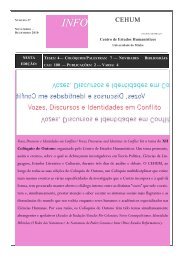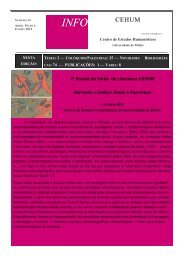Diacritica 25-2_Filosofia.indb - cehum - Universidade do Minho
Diacritica 25-2_Filosofia.indb - cehum - Universidade do Minho
Diacritica 25-2_Filosofia.indb - cehum - Universidade do Minho
Create successful ePaper yourself
Turn your PDF publications into a flip-book with our unique Google optimized e-Paper software.
210<br />
ÂNGELO MARTINGO<br />
Grewe, O., Kopiez, R. & Altenmuller, E. (2009), “Chills As an Indicator of Individual<br />
Emotional Peaks. Th e Neurosciences and MusicIII: Disorders and Plasticity”, Ann.<br />
N. Y. Acad. Sci. 1169, pp. 351–354.<br />
Hong, S. (2006), “Peak experience in music: A case study between listeners and performers”,<br />
in Baroni, M., Addessi, A. R., Caterina, R. & M. Costa (Eds.), Proceedings of<br />
the 9th International Conference on Music Perception and Cognition, Bologna, Alma<br />
Matter Studiorum University of Bologna, pp. 1176 -1182.<br />
Jacken<strong>do</strong>ff, R. (1992), “Musical processing and musical aff ect”, in Jones, M. & S.<br />
Holleran (Ed.): Cognitive basis of musical communication, Washington, American<br />
Psychological Association, pp. 51 -68.<br />
Juslin, P. N., & Zentner, M. (2002), “Current trends in the study of music and emotion:<br />
Overture”, Musicae Scientiae, Special Issue, 2001 -2002, pp. 3 -21<br />
Krumhansl, K. (1996). A perceptual analysis of Mozart’s Piano Sonata K.282: Segmentation,<br />
tension, and musical ideas. Music Perception, 13: 401 -432.<br />
–––– (2003), “Music and aff ect: Empirical and theoretical contributions from experimental<br />
psychology”, in Greer, D. (ed.), Musicology and sister disciplines, Past, present, future,<br />
Oxford, Oxford University Press, pp. 88 -99.<br />
Lamont. A. (2009), “Strong Experiences of Music in University Students”, in Louhivuori,<br />
J., Eerola, T., Saarikallio, S., Himberg, T. & Päivi -Sisko Eerola (Eds.), Proceedings<br />
of the 7th Triennial Conference of European Society for the Cognitive Sciences of Music,<br />
Jyväskylä, ESCOM, pp. <strong>25</strong>0 -<strong>25</strong>9.<br />
Lerdahl, F. & Jacken<strong>do</strong>ff, R. (1983), A generative theory of tonal music, Cambridge,<br />
MA, MIT Press.<br />
Lerdahl, F. (2001), Tonal pitch space, Oxford, Oxford University Press.<br />
Lowis, M. J. (1998), “Music and peak experience: an empirical study”, Mankind Quarterly<br />
32, pp. 203 -2<strong>25</strong>.<br />
–––– (2002), “Music as a Trigger for Peak experiences among a college staff s population”,<br />
Creativity Research Journal 14, pp. 351 -359.<br />
Marcus, M. (1980), A theory of syntactic recognition for natural language, Cambridge,<br />
MA, MIT Press.<br />
Martingo, A. (2006), “Testing Lerdahl’s tonal space theory – Performed expressive<br />
deviations and listener’s preferences”, in Baroni, R., A. Addessi & M. Costa (eds.),<br />
Proceedings of the 9th International Conference on Music Perception & Cognition<br />
(ICMPC9), Bolonha, SMPC/ESCOM, pp. 560 -561.<br />
–––– (2007a), “Making sense out of taste: Listener’s preferences of performed tonal music”,<br />
in Williamon, A. & D. Coimbra (eds.), Proceedings of the International Simposium<br />
of Performance Science, Porto, Casa da Música, pp. 245 -<strong>25</strong>0.<br />
<strong>Diacritica</strong> <strong>25</strong>-2_<strong>Filosofia</strong>.<strong>indb</strong> 210 05-01-2012 09:38:30



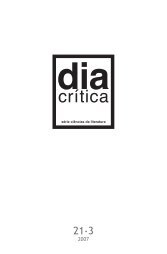

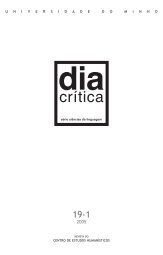



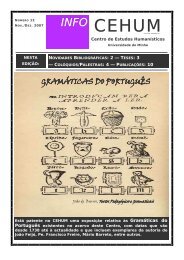

![Programa [pdf] - cehum - Universidade do Minho](https://img.yumpu.com/17305425/1/190x135/programa-pdf-cehum-universidade-do-minho.jpg?quality=85)


